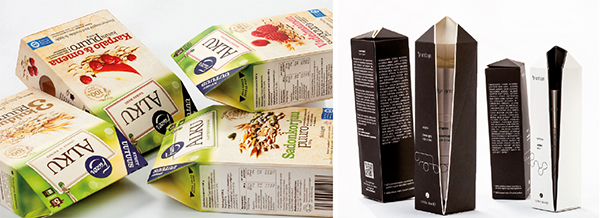Cellulose packaging – Data 2014
The Italian paper converting industry is among the most important in Europe. The annual report 2014 for the entire sector shows an upturn in production, exports and domestic consumption.
33.2% of the Italian packaging production is comprised of cellulose packaging, 24.5% of which involving the use of corrugated cardboard.
The Italian paper converting industry is among the most important at European level, placed third all told.
The sector’s end of year report for 2014 puts production at 4,849 t/000 (+ 2.2% compared to 2013).
Exports have marked a growth of 16.1%, confirming the orientation of Italian producers towards increasing their presence abroad. Imports have also grown considerably (+ 16%): showing a progressive uptrend in recent years.
Domestic consumption put in a + 2.3%, revealing a 1.9% growth of Italian output.

Final report for 2014 of the cellulose packaging segments
The paper and board packaging sector comprises various types: Corrugated cardboard boxes, folding cardboard cartons, large paper bags, shoppers, paper bags, cellulose drums, cardboard boxes of medium/high thickness, laminated cardboard boxes, wrapping paper, cardboard tubes etc.
The leading sector in terms of size of production is that of corrugated cardboard which, because of its function associated with transport, is widely applied in all sectors. It is followed by the folding carton sector.
With reference to data based on weight, cellulose packaging production is structured as follows: corrugated cardboard 73.6%, folding cartons and boxes in flat board 15.1%, high capacity bags 4%, others 7.3%.
Corrugated cardboard boxes
In 2014 the production of corrugated board packaging amounted to 3,570 t/000, up 2% compared to 2013.
An increase in both exports and domestic demand was seen.
According to the information presented by the Istituto Italiano Imballaggio database,43.6 % of corrugated cardboard packaging is used in the food and beverages area, with the exception of fresh fruit and vegetables which account for 14.7%; 12.9% is used in handling in the furniture industry, while the remaining 28.8% covers a multitude of areas (chemicals, electronics, electrical appliances, construction products, etc.).
Cases and boxes in flat board
The area is divided into two main areas: folding cartons (82.9%) and boxes in flat board (17.1%).
The production of folding cartons comprises around 51% of artefacts only made using card stock and the remaining 49% comprising containers combined with PE or aluminium film (the share of which is experiencing and uptrend). The combination of the plastic or aluminium film is generally necessary to give to the box particular high class characteristics, or for special needs related to use.In 2014 global production amounted to 731 t/000, up 4.4% on the previous year, following a decline in 2013 that has been fully recovered. Regarding the use of folding cartons and cardboard boxes, the breakdown is as follows: food 47.4%, Beverages 17.2% (essentially clusters), cosmetics and pharmaceuticals 10.1%, other non-food 25.3%.
Cardboard boxes are mainly used for packaging shoes, leather goods and clothing, with a global share of around 56%.
Large paper bags
The crisis that has affected most manufacturing sectors, and in particular has accentuated the downturn in the construction industry, which is the main outlet area for paper bags (62% of sales), resulting in a long period of stagnation. Since 2013 however a slow recovery has appeared to set in (+ 4.9% in 2013, + 2% in 2014), mainly driven by the growth in exports and a slight increase in domestic demand. The area of the construction industry absorbs the largest share (64.4%), while the remaining 35.6% are used in the following areas: animal feed, various types food and other segments.
Other sectors
Among other cellulose packaging families we find the shopper bags, cardboard tube packaging and accessories, wrapping paper (parchment, plasticized and simple), support sheets for the clothing, micro corrugated protection sheet, pouches and cellulose drums.
It is estimated that the global production of this area in 2014 totalled 353 t/000, down 0.6% compared to 2013. The downturn began in 2012. The decline was mainly driven by wrapping paper, corrugated paper, display cases and shoppers, while cellulose tubes have overall maintained their quantities.
Plinio Iascone
Istituto Italiano Imballaggio



















